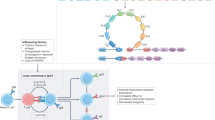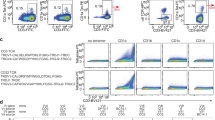Abstract
Because functional analysis of Fc receptors (FcRs) relies heavily on mouse models, the identification of another Fcγ receptor is particularly noteworthy. We demonstrate that FcγRIV, identified here as the mouse ortholog of primate FcγRIII, required association of the FcR γ-chain for optimal expression and function on myeloid cells; its signaling potential was also enhanced by a cytoplasmic 'YEEP' motif that was able to recruit the adaptor molecule Crk-L and phosphatidylinositol-3-OH kinase. Unexpectedly, FcγRIV 'preferentially' bound immunoglobulin E antibodies of the 'b' allotype (IgEb) as well as IgG2a and IgG2b antibodies. Ligation of FcγRIV by antigen-IgEb immune complexes promoted macrophage-mediated phagocytosis, presentation of antigen to T cells, production of proinflammatory cytokines and the late phase of cutaneous allergic reactions. IgEb antibody–mediated modification of macrophage responses may therefore influence mouse asthma models and strain-dependent differences in parasite susceptibility.
This is a preview of subscription content, access via your institution
Access options
Subscribe to this journal
Receive 12 print issues and online access
$209.00 per year
only $17.42 per issue
Buy this article
- Purchase on Springer Link
- Instant access to full article PDF
Prices may be subject to local taxes which are calculated during checkout





Similar content being viewed by others
References
Ravetch, J.V. & Kinet, J.P. Fc receptors. Annu. Rev. Immunol. 9, 457–492 (1991).
Ravetch, J.V. & Clynes, R.A. Divergent roles for Fc receptors and complement in vivo. Annu. Rev. Immunol. 16, 421–432 (1998).
Heyman, B. Regulation of antibody responses via antibodies, complement, and Fc receptors. Annu. Rev. Immunol. 18, 709–737 (2000).
Qiu, W.Q., de Bruin, D., Brownstein, B.H., Pearse, R. & Ravetch, J.V. Organization of the human and mouse low-affinity FcγR genes: duplication and recombination. Science 248, 732–735 (1990).
Davis, R.S. et al. Fc receptor homologs: newest members of a remarkably diverse Fc receptor gene family. Immunol. Rev. 190, 123–136 (2002).
Nimmerjahn, F. & Ravetch, J.V. Divergent immunoglobulin g subclass activity through selective Fc receptor binding. Science 310, 1510–1512 (2005).
Ravetch, J.V. & Lanier, L.L. Immune inhibitory receptors. Science 290, 84–89 (2000).
van der Pol, W. & van de Winkel, J.G. IgG receptor polymorphisms: risk factors for disease. Immunogenetics 48, 222–232 (1998).
Hibbs, M.L., Hogarth, P.M. & McKenzie, I.F. The mouse Ly-17 locus identifies a polymorphism of the Fc receptor. Immunogenetics 22, 335–348 (1985).
Davis, R.S., Ehrhardt, G.R., Leu, C.M., Hirano, M. & Cooper, M.D. An extended family of Fc receptor relatives. Eur. J. Immunol. 35, 674–680 (2005).
Mechetina, L.V., Najakshin, A.M., Alabyev, B.Y., Chikaev, N.A. & Taranin, A.V. Identification of CD16–2, a novel mouse receptor homologous to CD16/FcγRIII. Immunogenetics 54, 463–468 (2002).
Nimmerjahn, F., Bruhns, P., Horiuchi, K. & Ravetch, J.V. FcγRIV: a novel FcR with distinct IgG subclass specificity. Immunity 23, 41–51 (2005).
Songyang, Z. et al. SH2 domains recognize specific phosphopeptide sequences. Cell 72, 767–778 (1993).
Hazenbos, W.L. et al. Impaired IgG-dependent anaphylaxis and Arthus reaction in FcγRIII (CD16) deficient mice. Immunity 5, 181–188 (1996).
Shibuya, A. et al. Fcα/μ receptor mediates endocytosis of IgM-coated microbes. Nat. Immunol. 1, 441–446 (2000).
Amigorena, S., Salamero, J., Davoust, J., Fridman, W.H. & Bonnerot, C. Tyrosine-containing motif that transduces cell activation signals also determines internalization and antigen presentation via type III receptors for IgG. Nature 358, 337–341 (1992).
Nagai, H., Sakurai, T., Inagaki, N. & Mori, H. An immunopharmacological study of the biphasic allergic skin reaction in mice. Biol. Pharm. Bull. 18, 239–245 (1995).
Hughes, A.L. Gene duplication and recombination in the evolution of mammalian Fc receptors. J. Mol. Evol. 43, 4–10 (1996).
van Hage-Hamsten, M. et al. Associations of Fc epsilon R1-β polymorphisms with immunoglobin E antibody responses to common inhalant allergens in a rural population. Clin. Exp. Allergy 32, 838–842 (2002).
Pandey, J.P. Genetic polymorphism of Fc. Science 311, 1376–1377 (2006).
Paterson, T., Innes, J., McMillan, L., Downing, I. & Carter, M.C. Variation in IgG1 heavy chain allotype does not contribute to differences in biological activity of two human anti-Rhesus (D) monoclonal antibodies. Immunotechnology 4, 37–47 (1998).
Shinkai, Y., Nakauchi, H., Honjo, T. & Okumura, K. Mouse immunoglobulin allotypes: multiple differences between the nucleic acid sequences of the IgEa and IgEb alleles. Immunogenetics 27, 288–292 (1988).
Radaev, S., Motyka, S., Fridman, W.H., Sautes-Fridman, C. & Sun, P.D. The structure of a human type III Fcγ receptor in complex with Fc. J. Biol. Chem. 276, 16469–16477 (2001).
Kaneko, Y., Nimmerjahn, F. & Ravetch, J.V. Anti-inflammatory activity of immunoglobulin G resulting from Fc sialylation. Science 313, 670–673 (2006).
Bartlett, W.C., Kelly, A.E., Johnson, C.M. & Conrad, D.H. Analysis of murine soluble FcεRII sites of cleavage and requirements for dual-affinity interaction with IgE. J. Immunol. 154, 4240–4246 (1995).
Haczku, A. et al. CD23 deficient mice develop allergic airway hyperresponsiveness following sensitization with ovalbumin. Am. J. Respir. Crit. Care Med. 156, 1945–1955 (1997).
Cernadas, M. et al. CD23 and allergic pulmonary inflammation: potential role as an inhibitor. Am. J. Respir. Cell Mol. Biol. 20, 1–8 (1999).
Maurer, D. et al. The high affinity IgE receptor (FcεRI) mediates IgE-dependent allergen presentation. J. Immunol. 154, 6285–6290 (1995).
Dolovich, J. et al. Late cutaneous allergic responses in isolated IgE-dependent reactions. J. Allergy Clin. Immunol. 52, 38–46 (1973).
Holden, C.A. Atopic dermatitis–messengers, second messengers and cytokines. Clin. Exp. Dermatol. 18, 201–207 (1993).
Finkelman, F.D., Pearce, E.J., Urban, J.F., Jr. & Sher, A. Regulation and biological function of helminth-induced cytokine responses. Immunol. Today 12, A62–A66 (1991).
Butterworth, A.E. Cell-mediated damage to helminths. Adv. Parasitol. 23, 143–235 (1984).
Onah, D.N. et al. Mucosal defense against gastrointestinal nematodes: responses of mucosal mast cells and mouse mast cell protease 1 during primary strongyloides venezuelensis infection in FcRγ-knockout mice. Infect. Immun. 68, 4968–4971 (2000).
James, S.L. & Nacy, C. Effector functions of activated macrophages against parasites. Curr. Opin. Immunol. 5, 518–523 (1993).
Oswald, I.P., Wynn, T.A., Sher, A. & James, S.L. Interleukin 10 inhibits macrophage microbicidal activity by blocking the endogenous production of tumor necrosis factor alpha required as a costimulatory factor for interferon gamma-induced activation. Proc. Natl. Acad. Sci. USA 89, 8676–8680 (1992).
James, S.L. & Glaven, J. Macrophage cytotoxicity against schistosomula of Schistosoma mansoni involves arginine-dependent production of reactive nitrogen intermediates. J. Immunol. 143, 4208–4212 (1989).
Cheever, A.W. A comparative study of Schistosoma mansoni infections in mice, gerbils, multimammate rats and hamsters. Ii. qualitative pathological differences. Am. J. Trop. Med. Hyg. 14, 227–238 (1965).
von Lichtenberg, F. & Byram, J.E. Pulmonary cell reactions in natural and acquired host resistance to Schistosoma mansoni. Am. J. Trop. Med. Hyg. 29, 1286–1300 (1980).
Sher, A., Correa-Oliveira, R., Hieny, S. & Hussain, R. Mechanisms of protective immunity against Schistosoma mansoni infection in mice vaccinated with irradiated cercariae. IV. analysis of the role of IgE antibodies and mast cells. J. Immunol. 131, 1460–1465 (1983).
Aban, J.L. et al. A fatty acid binding protein from Fasciola hepatica induced protection in C57/BL mice from challenge infection with Schistosoma bovis. Vet. Parasitol. 83, 107–121 (1999).
Davis, R.S., Stephan, R.P., Chen, C.C., Dennis, G., Jr. & Cooper, M.D. Differential B cell expression of mouse Fc receptor homologs. Int. Immunol. 16, 1343–1353 (2004).
Tsutsui, H. et al. IFN-γ-inducing factor up-regulates Fas ligand-mediated cytotoxic activity of murine natural killer cell clones. J. Immunol. 157, 3967–3973 (1996).
Takai, T., Li, M., Sylvestre, D., Clynes, R. & Ravetch, J.V. FcR γ chain deletion results in pleiotrophic effector cell defects. Cell 76, 519–529 (1994).
Kitaura, J. et al. Evidence that IgE molecules mediate a spectrum of effects on mast cell survival and activation via aggregation of the FcεRI. Proc. Natl. Acad. Sci. USA 100, 12911–12916 (2003).
Onishi, M. et al. Applications of retrovirus-mediated expression cloning. Exp. Hematol. 24, 324–329 (1996).
Maenaka, K., van der Merwe, P.A., Stuart, D.I., Jones, E.Y. & Sondermann, P. The human low affinity Fcγ receptors IIa, IIb, and III bind IgG with fast kinetics and distinct thermodynamic properties. J. Biol. Chem. 276, 44898–44904 (2001).
Campbell, P.A., Canono, B.P. & Drevets, D.A. in Current Protocol in Immunology (eds. Coligan, J. E., Kruisbeek, A.M., Margulies, D.H., Shevach, E.M. & Strober, W) 14.6.1–14.6.13 (John Wiley & Sons, Hoboken, New Jersey, 1996).
Strong, P., Townsend, P., Mackay, R., Reid, K.B. & Clark, H.W. A recombinant fragment of human SP-D reduces allergic responses in mice sensitized to house dust mite allergens. Clin. Exp. Immunol. 134, 181–187 (2003).
Acknowledgements
We thank K. Maenaka and S. Nakae for discussions and suggestions; T. Kawakami, T. Kitamura, H. Tsutsui, K. Nakanishi, G.R.A. Ehrhardt, Z. Pancer, H. Kubagawa and J.F. Kearney for reagents or mice; G.L. Gartland, M. Hotomi, L.A. Gartland and Y. Kubagawa for technical assistance; and B.R. Herrin, M. Flurry, A. Brookshire and D. Lang for help in manuscript preparation. Supported by the National Institutes of Health (AI 39816; K08 award AI55638 to R.S.D.), the Charles A. Dana Foundation Program in Human Immunology (R.S.D.) and the Howard Hughes Medical Institute (M.H. and M.D.C.).
Author information
Authors and Affiliations
Contributions
M.H. designed and did experiments and prepared the manuscript; R.S.D. assisted in experimental design and manuscript preparation; W.D.F. did the surface plasmon resonance analysis; S.N. and K.S. did the structural analysis; H.Y. and K.K. did the glycosylation analysis; R.P.S. contributed to the PCR analysis; and M.D.C. contributed to the study design, data interpretation and manuscript preparation.
Corresponding author
Ethics declarations
Competing interests
The authors declare no competing financial interests.
Supplementary information
Supplementary Fig. 1
Specificity of polyclonal antibodies to FcγRIV. (PDF 32 kb)
Supplementary Fig. 2
Association of FcγRIV with FcRγ and enhancement of FcγRIV surface expression by FcRγ. (PDF 30 kb)
Supplementary Fig. 3
The 2.4G2 monoclonal antibody recognizes both FcγRIII and FcγRIV. (PDF 45 kb)
Supplementary Fig. 4
FcγRIV phosphorylation and association with Crk-L and PI3K. (PDF 23 kb)
Supplementary Fig. 5
Comparative analysis of the mouse and human Ig isotype-binding specificities for FcγRIII and FcγRIV. (PDF 75 kb)
Supplementary Fig. 6
The peritoneal cavity cells from C57BL/6, BALB/c, Fcgr3−/−, or Fcer1g−/− mice were stained with anti-CD11b, anti-Gr-1, and anti-B220/CD45R. (PDF 44 kb)
Supplementary Table 1
Comparison of FcγRIII and FcγRIV expression by different cell lines. (PDF 15 kb)
Supplementary Table 2
Ig binding affinities of FcγRIII and FcγRIV. (PDF 14 kb)
Rights and permissions
About this article
Cite this article
Hirano, M., Davis, R., Fine, W. et al. IgEb immune complexes activate macrophages through FcγRIV binding. Nat Immunol 8, 762–771 (2007). https://doi.org/10.1038/ni1477
Received:
Accepted:
Published:
Issue Date:
DOI: https://doi.org/10.1038/ni1477
This article is cited by
-
IgE-mediated enhancement of CD4+ T cell responses requires antigen presentation by CD8α− conventional dendritic cells
Scientific Reports (2016)
-
Inhibition of CD23-mediated IgE transcytosis suppresses the initiation and development of allergic airway inflammation
Mucosal Immunology (2015)
-
The production and regulation of IgE by the immune system
Nature Reviews Immunology (2014)
-
Genome-Wide Profiling of In Vivo LPS-Responsive Genes in Splenic Myeloid Cells
Molecules and Cells (2013)
-
Of Mice and Men: The Need for Humanized Mouse Models to Study Human IgG Activity in Vivo
Journal of Clinical Immunology (2013)



